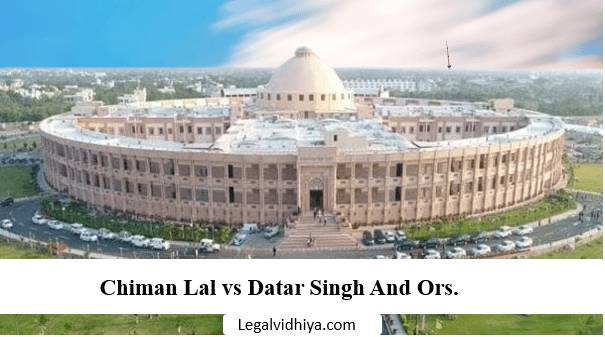
Chiman Lal vs Datar Singh And Ors.
| Citation | 1998 CriLJ 267 |
| Date of Judgment | 11 March, 1997 |
| Court | Rajasthan High Court |
| Petitioner | Chiman Lal |
| Respondents | Datar Singh & Ors. |
| Bench | AK Singh |
| Referred Statutes | Sections 200, 202, 397, 482, 47 Criminal Procedure Code. Section 114(g) and 3 of Evidence Act. |
Facts of the Case
A non-bailable warrant was issued against the petitioner, and the non-petitioner no.1 Dartar Singh, an Assistant Sub-inspector, was empowered to do the arrest. He was accompanied by non-petitioners no. 2-5 for the execution of the same. He went to the petitioner’s home to make an arrest when, abuse at the hands of the police personnel(s) took place against the petitioner and other inmates of the house. The family included the Complainant’s wife, three daughters and two sons. A son and wife of the complainant were also forcibly taken to the police station. There are 6 witnesses to the incident, with three, Sunil Kumar, Salil Mohd. And Yusuf Khan being the eyewitness. Although, the counsel for non-petitioners pleads that everything has been done in accordance with the prescribed law, the petitioner challenges the abusive and forceful nature of the arrest made. For the same, cognizance was taken by the learned Magistrate and inquiry took place u/s 200 and 202 of Criminal Procedure Court. The learned Additional Chief Judicial Magistrate dismissed the complaint as he believed that the other witnesses including the wife and daughter(s) of the complainant have not been questioned in the Court of law and hence, these evidences cannot be substantiated. In a revision petition at the Special Court (ST/SC), similar conclusions were drawn and the petition was dismissed.
Issues
Whether the lower Courts are right in dismissing the petition?
Whether any abuse of the process of law has taken place at the hands of the non-petitioner(s)?
Arguments
The petitioner has challenged the decisions rendered by both the lower Courts u/s 482 of CrPC. The counsel also believes that the learned Additional Chief Judicial Magistrate was wrong in dismissing the complaint since, there are sufficient evidence(s) to proceed.
On the other hand, the non-petitioners believe that this petition is not maintainable u/s 482 since the petitioner is invoking the revisional Jurisdiction of the Court which shall subside u/s 397 CrPC and, section 397(3) debars the second revision of the same facts.
Judgment
The learned High Court judge held the dismissal of the complainant by both the lower Courts as wrong. In this case, cognizance was already taken of the offence and it was no more up to the learned Magistrate to take the cognizance. After taking, due cognizance of the complaint and inquiry of the same in accordance to sections 200 and 202 CrPC, it was up to them to either conclude on the basis of sufficient grounds or dismiss it on the basis of the same u/s 203 CrPC. The learned Additional Chief Judicial Magistrate was mis-directed when he believed that he had to take the cognizance of the complaint post-inquiry u/s 200 and 202. They only had to either proceed with u/s 203 or 204, which the Additional Chief Judicial Magistrate did not do. So it is onto this Court to decide whether this case has ‘sufficient grounds to proceed’ or not.
In perusal of the same, the angle of Prima Facie case read with Section 3 of the Evidence Act must be taken into account. Moreover, the reason stepped up by the lower Courts shall not apply. The absence of examination of some of the witnesses at the Court of Law cannot be a reason for dismissal since the general rule of evidence followed is ‘best evidence rule’. This rule means that the best evidence shall be presented before the Court by the party on whom the burden lies. And, if that’s not possible the second best evidence shall be presented and the Court must direct and work accordingly. The Additional Chief Judicial Magistrate and the Special Judge did not take into account the importance of other witnesses and discarded the same without any reasoning. The judge(s) might’ve drawn an incorrect inference of section 114(g) of the Evidence Act, which doesn’t falsify the whole case of the party if evidence is not produced but only discusses the adverse impacts of the same. Therefore, the Hon’ble Judge of this Court allowed the petition u/s 482 and quashed the orders given by the Additional Chief Judicial Magistrate and the Special Judge. The Court also directed Additional Chief Judicial Magistrate to conduct inquiry u/s 202 while keeping in mind the ‘best evidence’ rule.
Secondly, in deciding whether ill-treatment has taken place against the complainant and his family, the Court referred to Section 47(2) of the CrPC which mandates the police officer to seek permission before entering any house to make an arrest. In cases of presence of females inside the house, opportunity shall be given to them to withdraw themselves from the property and process. This is to balance the integrity and dignity of individuals and smooth enforcement of law. But in the instant case, there are no sufficient grounds to conclude any such behaviour from both the parties. Therefore, it will be open to the parties to proceed for the same at further and appropriate stage before the Court.
Hence, the petition is partly allowed.
References
https://indiankanoon.org/doc/1544644/
https://www.lawweb.in/2013/04/complainant-is-under-legal-obligation.html?m=1
written by Disha Bhalla intern under legal vidhiya.




0 Comments